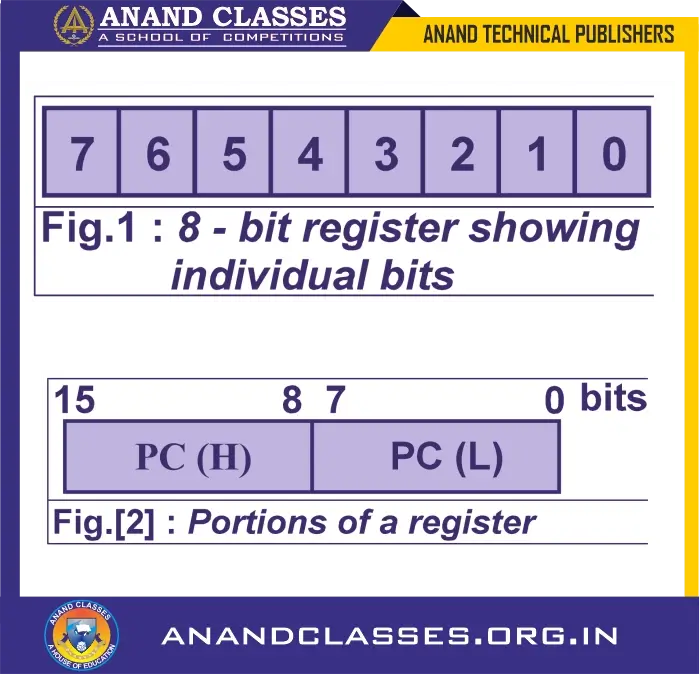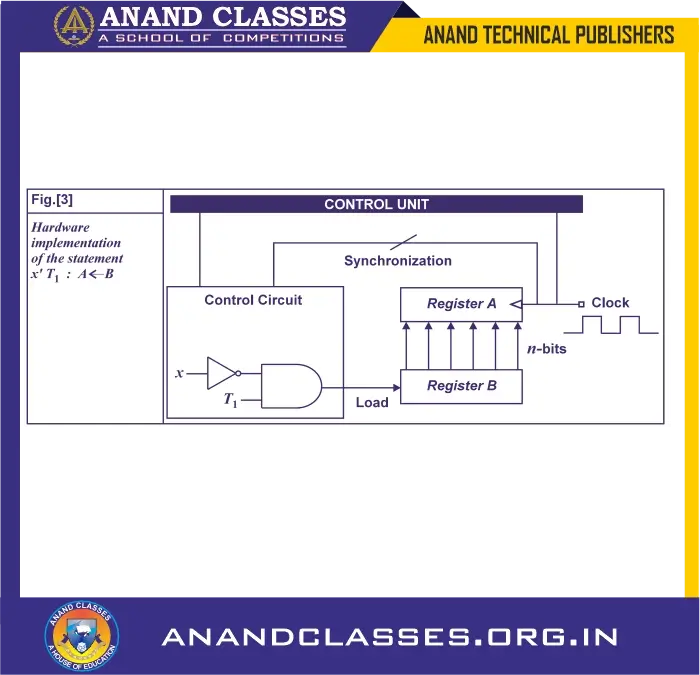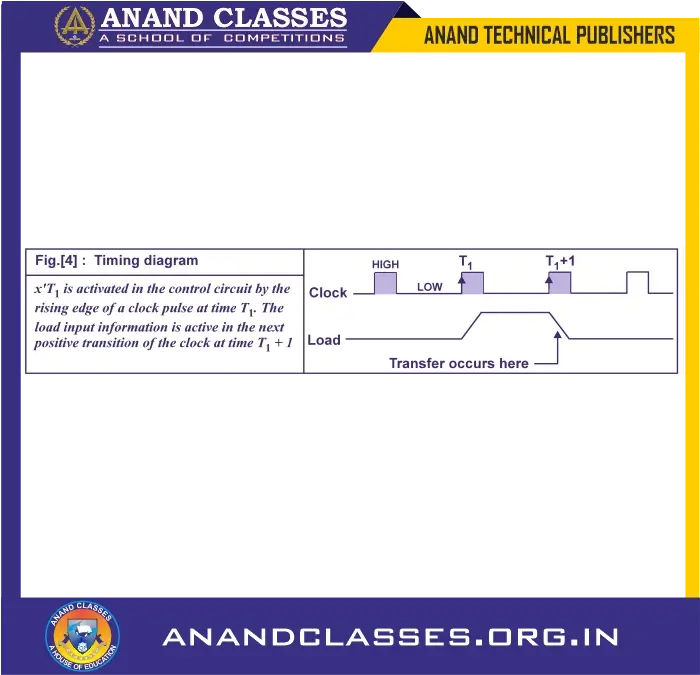Computer Organization and Architecture – Study Material Notes
Authored by: Neeraj Anand
Published by: Anand Technical Publishers
Under the Brand: Anand Classes
For the Syllabus of Top Engineering Institutes (NITs, IITs, IIITs, VIT, BITS, DTU,
🎓 Educational Institutions Covered
This content is suitable for Computer Organization and Architecture syllabus of:
- All NITs including NIT Trichy, NIT Surathkal, NIT Rourkela, etc.
- All IITs including IIT Bombay, IIT Delhi, IIT Madras, etc.
- Top Deemed & State Universities: VIT, BITS Pilani, DTU, NSUT, SRM, Anna University, etc.
📌 Related Posts:
Computer Registers Study Material Notes for B.Tech (IITs/NITs), PTU, GNDU, GATE, PSU, IES
📆 Suitable For:
- B.Tech / B.E. Students in Computer Science, Electronics, and Electrical Engineering.
- Competitive Exams Preparation (e.g., GATE, PSU).
REGISTER TRANSFER LANGUAGE
A register transfer language is a system for expressing in symbolic form the microoperation sequences among the registers of a digital module.
A statement in a register-transfer language consists of:
- A control function, and
- A list of microoperations
🔹 Control Function
- The Control Function specifies the control condition and timing sequence for executing the listed microoperations.
- The control functions that Initiated by timing signals that sequence operations one at a time.
- The state of control functions may also depend on results of previous operations.
- The Control Function Is a binary variable:
- 1 initiates the operation
- 0 inhibits the operation
🔹 Microoperations
The microoperations specify the elementary operations to be performed on information stored in registers.
Types of Microoperations:
The types of microoperations most often encountered in digital systems can be classified into four categories :
- Inter-register-transfer microoperations
➤ Move binary information between registers without changing its content. - Arithmetic microoperations
➤ Perform arithmetic (addition, subtraction, etc.) on numbers in registers. - Logic microoperations
➤ Perform bitwise operations (AND, OR, etc.) on register data. - Shift microoperations
➤ Perform shifting operations using shift registers.
🔹 Special Symbols in RTL
- Each microoperation has a special symbol.
- Directly linked to the digital hardware that implements it.
- Cannot be separated from the registers and the functions it defines.
🔹 Data Types in Registers
The microoperations performed on the information stored in registers depend on the type of data that reside in the registers. The binary information commonly found in registers of digital computers can be
classified into three categories :
- Numerical data
➤ Binary numbers or BCD used in arithmetic computations. - Nonnumerical data
➤ Alphanumeric characters or binary-coded symbols for specific applications. - Instruction codes and addresses
➤ Control information used for data-processing requirements in the system.
📌 Related Posts:
Computer Registers Study Material Notes for B.Tech (IITs/NITs), PTU, GNDU, GATE, PSU, IES
HOW TO REPRESENT A STATEMENT IN REGISTER TRANSFER LANGUAGE?
🔹 Conventions in RTL:
The following conventions are observed in Register Transfer Language :
- Registers
➤ Represented using capital letters (optionally followed by numbers).
➤ Example:- AR = Address Register (The register that holds an address for the memory unit is called a memory address register)
- PC = Program Counter
- IR = Instruction Register
- AC = Accumulator Register (processor register)

Bit Numbering
➤ In an n-bit register:
The individual bits in an n-bit register (flip – flops) are numbered in sequence from 0 to (n – 1), starting from 0 in the rightmost position and increasing the numbers towards left. Figure.1 shows the 8-bit register.
Byte Partitioning Example
➤ A 16-bit register like PC is partitioned as:
A 16-bit program counter register (PC) is partitioned into two parts as shown in figure.2. The symbol L (for low order byte) is assigned to the bits 0 through 7 and symbol H (for high order byte) is assigned to the bits 8 through 15.
🔹 Data Transfer Symbol
Data transfer from one register to another is designated in symbolic form by replacement operator (←).
- Transfer Syntax:
A ← B
➤ Transfers content of register B to register A
➤ during transfer the contents of register B remain unchanged
🔹 Control Function Syntax
A statement that specifies a register transfer implies that circuits are available from the outputs of the source register to the cell inputs of the destination register.
Normally, we do not want this transfer to occur with every clock pulse, but only under a predetermined condition. The condition that determines when the transfer is to occur is called a control function. A control function is a boolean function that can be equal to 1 or 0. This can be specify by means of an If – then statement.
The control function is included with the statement as follows :
If (x’T1 = 1) then (A←B)
where x’T1 is a control signal generated from the control circuit. It symbolizes the requirement that the transfer operation be executed by the hardware only when the Boolean function x’T1 = 1, i.e., when variable x = 0 and timing variable T1 = 1.
The control function is either 1 (HIGH) or 0 (LOW). The control function is terminated with a colon. The control function is included in the above statement as follows :
x’T1 : A←B
The transfer operation be executed by the hardware only if x’T1 = 1.
🔹 Hardware Implementation of RTL Statement
Every statement written in a register-transfer language implies a hardware construction for implementing the transfer. Figure[3] shows the implementation of the statement written.

Figure.3 shows the transfer of n-bit information from register B to A. The n-outputs of register B are connected to the n-inputs of register A. Register B has a load input that is activated by the control variable x’T1. The control variable x’T1 is synchronized with the same clock as applied to the register A.
In the timing diagram shown in figure.4 , x’T1 is activated in the control circuit by the rising edge of a clock pulse at time T1. The load input information is active in the next positive transition of the clock at time T1 + 1 and information is then loaded into the register A. x’T1 may deactivated at time T1 + 1 ; otherwise, the transfer will occur with every clock pulse transition while x’T1 remains active.

BASIC SYMBOLS USED IN REGISTER TRANSFER LANGUAGE
Registers are denoted by capital letters, and numerals may follow the letters. Subscripts are used to distinguish individual cells of the register. Parentheses are used to define a portion of a register.
The arrow denotes a transfer of information and the direction of transfer. A colon terminates a control function, and the comma is used to separate two or more operations that are executed at the same time.
The square brackets are used in conjunction with memory transfer. The letter M designates a memory word, and the register enclosed inside the square brackets provides the address for the memory.
The table shows the basic symbols of the register transfer notation.
| Symbol | Description | Examples |
|---|---|---|
| Letters and numerals | Specifies a register | MAR, A, MBR, R1 |
| Subscript | Specifies a bit of a register | A2, B4, A3, B6 |
| Parentheses ( ) | Specifies a part of register | R1 (0–7), R1 (L) |
| Arrow ← | Specifies a transfer of information | A←B |
| Colon : | Terminates a control function | x’ T0 : |
| Comma , | Separates two microoperations | A←B , B←A |
| Square brackets [ ] | Specifies an address for memory transfer | M [AR] |
Table.[1]: Basic Symbols for Register Transfer
The statement :
T2 : A (0–7) ← B (0–7) , B (0–7) ← A (0–7)
specifies an operation that exchanges the lower order contents of registers A and B during one common clock pulse provided that T2 = 1. This simultanous operation is possible in registers with Master – Slave / Edge Triggered flip-flops.
Computer Organization and Architecture Study Material and Notes by Anand Technical Publishers Authored by Neeraj Anand
Anand Classes, under the trusted brand of Anand Technical Publishers, proudly presents expertly crafted study material notes authored by Neeraj Anand—designed specifically to cover the syllabus of leading institutes such as:
- National Institutes of Technology (NITs) including NIT Surathkal, NIT Rourkela, NIT Warangal, and many more.
- Indian Institutes of Technology (IITs) such as IIT Kharagpur, IIT Madras, IIT Kanpur, IIT Delhi, IIT Guwahati, and others.
- Renowned universities and private institutions like VIT Vellore, BITS Pilani, Anna University, SRMIST, Jadavpur University, IIIT Hyderabad, Delhi Technological University, and many more.
- Technical universities including AKTU, RGPV, RTU, VTU, JNTUH, CSVTU, and others.
Why Choose Anand Classes’ Study Material for Computer Organization and Architecture?
- Complete Coverage: Our notes are meticulously prepared to cover every important topic and concept required by the syllabus of top NITs, IITs, and universities.
- Easy to Understand: Authored by experienced educator Neeraj Anand, the material explains complex concepts in a simple and student-friendly language.
- Exam-Focused: With well-organized notes, solved examples, and practice questions, students can prepare confidently for semester exams and competitive tests.
- Updated Content: The material reflects the latest syllabus changes and incorporates industry-relevant information to keep students ahead.
- Trusted Brand: Anand Technical Publishers and Anand Classes have been trusted by thousands of engineering students for quality and clarity.
What Topics Are Covered?
- Basics of Computer Organization
- Instruction Set Architecture
- Processor Design and Control Unit
- Memory Systems and Hierarchy
- Input/Output Organization
- Pipelining and Parallelism
- Performance Evaluation and more
Computer Organization and Architecture is a fundamental subject designed to provide students with a comprehensive understanding of the internal structure, operational principles, and design of computer systems. The course covers key concepts such as data representation, instruction sets, CPU architecture, memory hierarchy, input/output organization, and control unit design. Students learn about various types of processors, including RISC and CISC architectures, along with instruction pipelining, cache memory, and performance evaluation techniques. The curriculum also delves into microprogramming, arithmetic operations, and the interface between hardware and software. This course aims to bridge the gap between hardware and software, equipping students with the ability to analyze, design, and optimize computer systems. It lays a solid foundation for advanced studies in computer engineering, embedded systems, and system architecture, and is essential for students aspiring to excel in hardware design, system programming, and computer architecture research.
Who Can Benefit?
Whether you are studying at any of the 30+ NITs, 20+ IITs, leading private universities, or state technical universities, these notes will support your learning and boost your academic performance.
Get your copy of the Computer Organization and Architecture study material by Anand Classes today and step confidently towards academic success!
Computer Organization and Architecture Course Study Material and Notes For following Engineering Colleges Courses :
NIT Trichy (Tamil Nadu), NIT Surathkal (Karnataka), NIT Rourkela (Odisha), NIT Warangal (Telangana), NIT Calicut (Kerala), VNIT Nagpur (Maharashtra), MNIT Jaipur (Rajasthan), NIT Kurukshetra (Haryana), MNNIT Allahabad (Uttar Pradesh), SVNIT Surat (Gujarat), NIT Durgapur (West Bengal), NIT Jamshedpur (Jharkhand), NIT Jalandhar (Punjab), MANIT Bhopal (Madhya Pradesh), NIT Hamirpur (Himachal Pradesh), NIT Patna (Bihar), NIT Raipur (Chhattisgarh), NIT Silchar (Assam), NIT Srinagar (Jammu and Kashmir), NIT Agartala (Tripura), NIT Arunachal Pradesh (Arunachal Pradesh), NIT Delhi (Delhi), NIT Goa (Goa), NIT Manipur (Manipur), NIT Meghalaya (Meghalaya), NIT Mizoram (Mizoram), NIT Nagaland (Nagaland), NIT Puducherry (Puducherry), NIT Sikkim (Sikkim), NIT Uttarakhand (Uttarakhand), NIT Andhra Pradesh (Andhra Pradesh)
IIT Kharagpur, IIT Bombay, IIT Madras, IIT Kanpur, IIT Delhi, IIT Guwahati, IIT Roorkee, IIT Bhubaneswar, IIT Gandhinagar, IIT Hyderabad, IIT Jodhpur, IIT Patna, IIT Ropar, IIT Indore, IIT Mandi, IIT BHU Varanasi, IIT Palakkad, IIT Tirupati, IIT Bhilai, IIT Goa, IIT Jammu, IIT Dharwad, IIT Dhanbad
Vellore Institute of Technology (VIT), Jadavpur University, SRM Institute of Science and Technology (SRMIST), Anna University, Birla Institute of Technology and Science Pilani (BITS Pilani), Amrita Vishwa Vidyapeetham, Jamia Millia Islamia, Institute of Chemical Technology Mumbai (ICT Mumbai), Shanmugha Arts Science Technology & Research Academy (SASTRA), Thapar Institute of Engineering and Technology, Indian Institute of Engineering Science and Technology Shibpur (IIEST Shibpur), International Institute of Information Technology Hyderabad (IIIT Hyderabad), PSG College of Technology, Delhi Technological University (DTU), Netaji Subhas University of Technology (NSUT), Manipal Institute of Technology, KIIT Bhubaneswar, Shiv Nadar University, IIIT Bangalore, DAIICT Gandhinagar
Dr. A.P.J. Abdul Kalam Technical University (AKTU), Rajiv Gandhi Proudyogiki Vishwavidyalaya (RGPV), Biju Patnaik University of Technology (BPUT), Rajasthan Technical University (RTU), Visvesvaraya Technological University (VTU), Anna University, Delhi Technological University (DTU), Uttarakhand Technical University, Himachal Pradesh Technical University, Chhattisgarh Swami Vivekanand Technical University (CSVTU), Jawaharlal Nehru Technological University Hyderabad (JNTUH), Madan Mohan Malaviya University of Technology (MMMUT), Dr. Babasaheb Ambedkar Technological University (DBATU), I.K. Gujral Punjab Technical University (IKGPTU), Assam Science and Technology University (ASTU), Puducherry Technological University (PTU)
Popular Computer Courses in Punjab
- B.Tech in Computer Science and Engineering (CSE)
- BCA (Bachelor of Computer Applications)
- MCA (Master of Computer Applications)
- M.Tech in Computer Science and Engineering
- Diploma in Computer Engineering / Information Technology
- B.Sc. Computer Science
- M.Sc. Computer Science
- Certification courses in:
- Data Science
- Artificial Intelligence & Machine Learning
- Cybersecurity
- Cloud Computing
- Software Development
- Networking
- Web Development
Major Universities and Institutes Offering Computer Courses in Punjab
1. Punjab Technical University (PTU) / I.K. Gujral Punjab Technical University (IKGPTU), Jalandhar
- Offers B.Tech, M.Tech, MCA, and other IT-related courses.
2. Punjabi University, Patiala
- BCA, MCA, B.Sc. (Computer Science), M.Sc. (Computer Science)
3. Guru Nanak Dev University (GNDU), Amritsar
- B.Tech (CSE), M.Tech (CSE), MCA, M.Sc. Computer Science
4. Chandigarh University, Mohali (Punjab)
- B.Tech, M.Tech, BCA, MCA, specialized computer certifications
5. Thapar Institute of Engineering and Technology, Patiala
- Renowned for B.Tech and M.Tech in Computer Science and Engineering
6. Lovely Professional University (LPU), Phagwara
- Wide range of computer science and IT programs, including B.Tech, M.Tech, BCA, MCA
7. Rayat Bahra University, Mohali
- Offers B.Tech, M.Tech, BCA, MCA, and IT certifications
8. DAV University, Jalandhar
- B.Tech CSE, M.Tech, BCA, MCA
9. Baba Farid University of Health Sciences (BFUHS), Faridkot
- Offers courses in Bioinformatics and IT applications in health sciences
10. Government Engineering Colleges in Punjab
- Like Government College of Engineering and Technology, Bathinda and others offering B.Tech CSE



